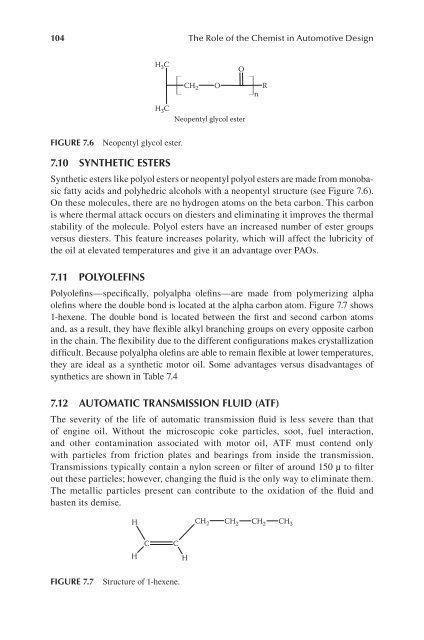THE ROLE OF THE
THE ROLE OF THE
THE ROLE OF THE
You also want an ePaper? Increase the reach of your titles
YUMPU automatically turns print PDFs into web optimized ePapers that Google loves.
104 The Role of the Chemist in Automotive Design<br />
7.10 syntHetIc esters<br />
Synthetic esters like polyol esters or neopentyl polyol esters are made from monobasic<br />
fatty acids and polyhedric alcohols with a neopentyl structure (see Figure 7.6).<br />
On these molecules, there are no hydrogen atoms on the beta carbon. This carbon<br />
is where thermal attack occurs on diesters and eliminating it improves the thermal<br />
stability of the molecule. Polyol esters have an increased number of ester groups<br />
versus diesters. This feature increases polarity, which will affect the lubricity of<br />
the oil at elevated temperatures and give it an advantage over PAOs.<br />
7.11 PolyoleFIns<br />
Polyolefins—specifically, polyalpha olefins—are made from polymerizing alpha<br />
olefins where the double bond is located at the alpha carbon atom. Figure 7.7 shows<br />
1-hexene. The double bond is located between the first and second carbon atoms<br />
and, as a result, they have flexible alkyl branching groups on every opposite carbon<br />
in the chain. The flexibility due to the different configurations makes crystallization<br />
difficult. Because polyalpha olefins are able to remain flexible at lower temperatures,<br />
they are ideal as a synthetic motor oil. Some advantages versus disadvantages of<br />
synthetics are shown in Table 7.4<br />
7.12 automatIc transmIssIon FluId (atF)<br />
The severity of the life of automatic transmission fluid is less severe than that<br />
of engine oil. Without the microscopic coke particles, soot, fuel interaction,<br />
and other contamination associated with motor oil, ATF must contend only<br />
with particles from friction plates and bearings from inside the transmission.<br />
Transmissions typically contain a nylon screen or filter of around 150 µ to filter<br />
out these particles; however, changing the fluid is the only way to eliminate them.<br />
The metallic particles present can contribute to the oxidation of the fluid and<br />
hasten its demise.<br />
H<br />
H<br />
C<br />
H 3 C<br />
H 3 C<br />
FIgure 7.6 Neopentyl glycol ester.<br />
FIgure 7.7 Structure of 1-hexene.<br />
C<br />
CH 2<br />
H<br />
CH 2<br />
O R<br />
n<br />
CH 2<br />
O<br />
Neopentyl glycol ester<br />
CH 2<br />
CH 3







